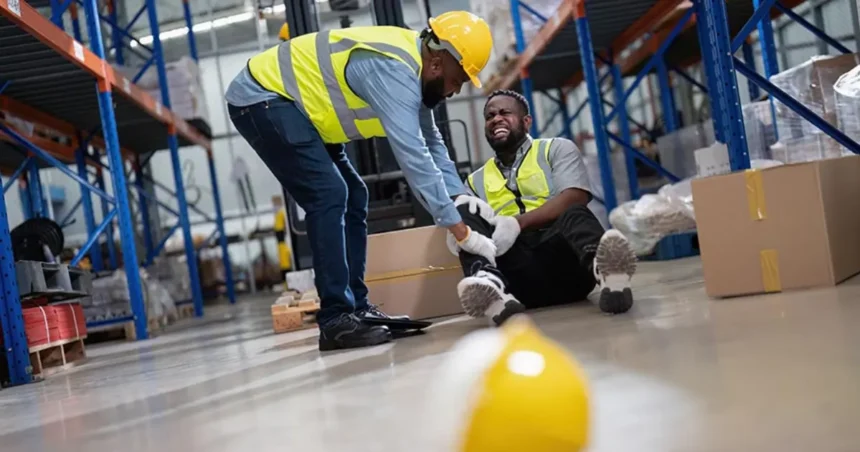Forklifts are powerful machines used in warehouses, construction sites, and factories to move heavy loads with ease. They’re like the workhorses of the industrial world, but with great power comes great responsibility. When not handled properly, what are the main causes of injuries when using forklifts? If you’ve ever been around a forklift, you know they’re not toys—they’re heavy, fast, and can be dangerous if you’re not careful. So, what are the main causes of injuries when using forklifts? Let’s break it down in a way that’s easy to understand, whether you’re a worker, a manager, or just curious.
In this article, we’ll dive into the main reasons why forklift accidents happen, share some real-world insights, and provide a detailed table summarizing the causes and how to prevent them. By the end, you’ll have a clear picture of what to watch out for and how to stay safe around these machines.
Why Forklift Injuries Happen
Forklift injuries don’t just happen out of the blue. They’re often the result of human error, equipment issues, or a lack of proper safety measures. According to the Occupational Safety and Health Administration (OSHA), about 100,000 forklift-related injuries occur in the U.S. each year, with around 100 of them being fatal. That’s a big number, and it shows just how important it is to understand what’s going wrong. Let’s explore the main causes of these injuries.
1. Lack of Proper Training
Imagine getting behind the wheel of a car without ever taking a driving lesson. Scary, right? The same applies to forklifts. One of the biggest causes of forklift injuries is operators who haven’t been properly trained. Driving a forklift isn’t just about steering and pressing pedals—it requires understanding how to balance loads, navigate tight spaces, and follow safety rules.
Untrained operators might not know how to handle a heavy load, judge distances, or react to unexpected obstacles. For example, they might not realize that a forklift’s center of gravity shifts when carrying a load, making it easier to tip over. Without training, they’re also less likely to know about workplace-specific hazards, like uneven floors or pedestrian zones.
2. Operator Error or Carelessness
Even trained operators can make mistakes, especially if they’re distracted or rushing. Operator error is a huge factor in forklift accidents. Common mistakes include speeding, turning too sharply, or not paying attention to surroundings. Picture this: an operator is trying to beat a deadline, so they zoom through the warehouse without checking for pedestrians. Next thing you know, someone’s hurt, or a load has fallen.
Carelessness also includes things like not wearing a seatbelt, ignoring weight limits, or using a forklift for something it’s not meant for—like giving a coworker a “ride” on the forks. These actions might seem harmless in the moment, but they can lead to disaster.
3. Poor Workplace Conditions
The environment where forklifts are used plays a big role in safety. Poor workplace conditions—like cluttered aisles, uneven floors, or bad lighting—can make accidents more likely. For instance, if a warehouse floor is littered with debris, a forklift’s wheels could get caught, causing it to tip or swerve. Narrow aisles or tight corners can also make it hard for operators to maneuver safely.
Wet or slippery floors are another hazard. If a forklift skids on a wet surface, the operator might lose control, leading to a crash or a dropped load. Poor lighting can hide obstacles or pedestrians, making it harder for operators to see what’s ahead.
4. Improper Load Handling
Forklifts are designed to carry heavy loads, but those loads need to be handled correctly. Improper load handling is a common cause of injuries. This includes overloading the forklift beyond its capacity, stacking loads unevenly, or not securing them properly. When a load is too heavy or unbalanced, the forklift can tip over, crushing anything—or anyone—in its path.
For example, if an operator raises a load too high while moving, the forklift becomes top-heavy and unstable. Or, if a load isn’t centered on the forks, it could fall off during a turn. These mistakes can lead to serious injuries for the operator and anyone nearby.
5. Mechanical Failures
Forklifts are machines, and like all machines, they can break down. Mechanical failures, such as brake issues, steering problems, or worn-out tires, can cause accidents. If a forklift’s brakes fail while it’s carrying a heavy load, the operator might not be able to stop in time to avoid a collision. Similarly, a hydraulic system failure could cause a load to drop unexpectedly.
Regular maintenance is key to preventing these issues, but if a company skips inspections or delays repairs, the risk of injury goes up. A poorly maintained forklift is like a ticking time bomb—it’s only a matter of time before something goes wrong.
6. Pedestrian Accidents
Forklifts and pedestrians don’t mix well. Many injuries happen when a forklift collides with a worker on foot. This can occur because the operator didn’t see the pedestrian, the pedestrian wasn’t paying attention, or there weren’t clear barriers separating foot traffic from forklift zones. For example, a worker might step into a forklift’s path while distracted by their phone, or an operator might not notice someone walking behind them.
Pedestrian accidents are especially dangerous because forklifts are heavy and can cause severe injuries, even at low speeds. Forklifts also have blind spots, making it harder for operators to see people nearby.
7. Tip-Overs
Tip-overs are one of the most dangerous types of forklift accidents. They happen when a forklift becomes unbalanced and flips over, often crushing the operator or nearby workers. Tip-overs can be caused by a combination of factors, like speeding, sharp turns, uneven surfaces, or improper load handling. For example, if an operator takes a corner too quickly with a heavy load raised high, the forklift’s center of gravity shifts, and over it goes.
Wearing a seatbelt can make a big difference in a tip-over, but many operators skip this step, thinking they can jump clear. Unfortunately, trying to jump out often leads to worse injuries.
8. Lack of Communication
Clear communication is essential in any workplace with forklifts. Without it, accidents are more likely. For example, if workers don’t use hand signals, horns, or radios to coordinate movements, an operator might not know a pedestrian is nearby or that another forklift is coming around a corner. Miscommunication can also lead to confusion about who’s responsible for certain tasks, like securing a load or clearing an aisle.
9. Fatigue or Stress
Operating a forklift requires focus and quick thinking. When operators are tired, stressed, or overworked, their reaction times slow down, and they’re more likely to make mistakes. Fatigue can cause an operator to miss a pedestrian, misjudge a turn, or forget to check a load’s weight. Long shifts, tight deadlines, or high-pressure environments can all contribute to this problem.
How to Prevent Forklift Injuries
Now that we’ve covered the main causes of forklift injuries, let’s talk about how to prevent them. Safety isn’t just about avoiding accidents—it’s about creating a culture where everyone prioritizes doing things the right way. Here are some practical steps:
-
Training and Certification: Make sure all operators are trained and certified according to OSHA standards. Training should cover forklift operation, load handling, and workplace-specific hazards.
-
Regular Maintenance: Inspect forklifts regularly for issues like worn tires, faulty brakes, or hydraulic leaks. Fix problems immediately to avoid accidents.
-
Clear Workplace Rules: Set clear rules for forklift operation, like speed limits, load capacities, and pedestrian zones. Use signs, barriers, and floor markings to guide traffic.
-
Load Management: Teach operators how to balance and secure loads properly. Never exceed the forklift’s weight limit, and keep loads low while moving.
-
Pedestrian Safety: Create separate paths for pedestrians and forklifts. Use mirrors, lights, or alarms to alert workers to forklift activity.
-
Encourage Communication: Use horns, hand signals, or radios to ensure everyone knows what’s happening. Encourage workers to speak up about safety concerns.
-
Rest and Breaks: Give operators regular breaks to prevent fatigue. Avoid scheduling overly long shifts that could lead to burnout.
-
Seatbelt Use: Always wear a seatbelt when operating a forklift. It’s a simple step that can save lives in a tip-over.
Table: Main Causes of Forklift Injuries and Prevention Tips
|
Cause |
Description |
Consequences |
Prevention Tips |
|---|---|---|---|
|
Lack of Proper Training |
Operators without proper training don’t know how to safely operate forklifts. |
Tip-overs, collisions, dropped loads. |
Provide OSHA-compliant training and certification for all operators. |
|
Operator Error/Carelessness |
Speeding, distractions, or ignoring safety rules. |
Collisions, pedestrian injuries, tip-overs. |
Enforce speed limits, seatbelt use, and focus on tasks. Retrain as needed. |
|
Poor Workplace Conditions |
Cluttered aisles, uneven floors, poor lighting, or slippery surfaces. |
Skids, tip-overs, collisions. |
Keep aisles clear, fix uneven floors, improve lighting, and clean spills promptly. |
|
Improper Load Handling |
Overloading, unbalanced loads, or raising loads too high. |
Dropped loads, tip-overs, crushed workers. |
Train operators on load limits and proper stacking. Keep loads low while moving. |
|
Mechanical Failures |
Faulty brakes, steering issues, or worn-out tires. |
Loss of control, collisions, dropped loads. |
Conduct regular maintenance and inspections. Fix issues immediately. |
|
Pedestrian Accidents |
Collisions between forklifts and workers on foot. |
Severe injuries or fatalities. |
Use barriers, mirrors, and alarms to separate pedestrians from forklift zones. |
|
Tip-Overs |
Forklift becomes unbalanced and flips over. |
Crushing injuries, fatalities. |
Avoid sharp turns, keep loads low, and ensure operators wear seatbelts. |
|
Lack of Communication |
No clear signals or coordination between workers and operators. |
Collisions, pedestrian injuries. |
Use horns, hand signals, or radios to communicate clearly. |
|
Fatigue or Stress |
Tired or stressed operators lose focus and make mistakes. |
Misjudgments, slow reactions, accidents. |
Schedule regular breaks and avoid overly long shifts. |
Real-World Examples
To make this more relatable, let’s look at a couple of real-world scenarios. In one case, a warehouse worker was injured when an untrained operator raised a load too high and it fell, striking the worker. Proper training could have taught the operator to keep loads low and secure. In another incident, a forklift tipped over because the operator was speeding on an uneven floor. Regular maintenance and workplace inspections could have caught the floor issue, and enforcing speed limits could have prevented the tip-over.
These stories show that forklift injuries are preventable with the right steps. It’s not just about one person—it’s about everyone in the workplace taking responsibility for safety.
Final Thoughts
Forklifts are essential tools, but they come with risks. what are the main causes of injuries when using forklifts?—lack of training, operator errors, poor workplace conditions, improper load handling, mechanical failures, pedestrian accidents, tip-overs, lack of communication, and fatigue—you can take steps to stay safe. Whether you’re an operator, a pedestrian, or a manager, safety starts with awareness and action.







